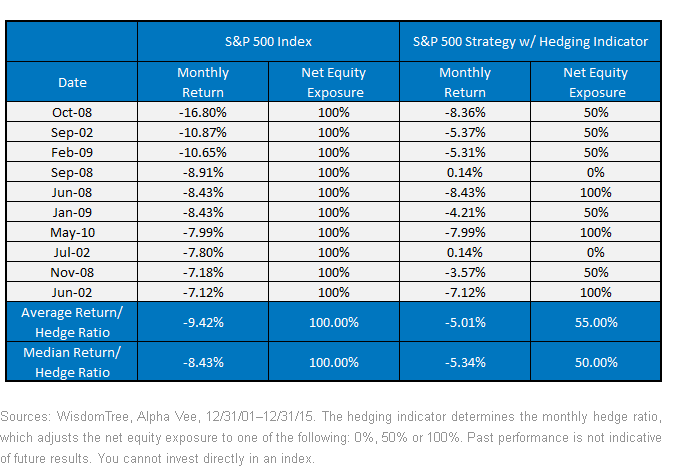2016 is off to a challenging start, and
fundamentals have been deteriorating. What are investors to do? Often, investors look to
alternative asset classes, such as
long/
short strategies, which typically aim to offer lower
volatility access to risk markets.
To that end, WisdomTree recently launched the
WisdomTree Dynamic Long/Short U.S. Equity Fund (DYLS), a
liquid alternative solution that applies a
dynamic hedging indicator to
hedging market risk during unfavorable times.
The Alternative Benefit
One of the primary benefits of alternative investments is the diversification they provide to traditional long-only asset classes such as stocks and bonds. Long/short strategies have the ability to profit from short positions, or hedge market risk, so they have the potential to protect investors, or even profit, when markets turn negative. Over time, being able to limit or buffer losses during unfavorable markets can prove critical to increasing portfolio returns while reducing risk.
DYLS has the ability to adjust its hedge ratios (or short percentage) on a monthly basis based on a rules-based dynamic indicator. Typically, when market fundamentals deteriorate or turn negative, the dynamic indicator will signal to hedge a percentage of the portfolio. Depending on market fundamentals, DYLS’s net equity exposure could range from 0% to 100%, allowing investors to potentially buffer negative market moves. The dynamic hedge indicator for DYLS for January 2016 signaled for the Fund to be 100% hedged.
Incorporating a Dynamic Hedge Ratio
Naturally, applying the rules-based dynamic hedging indicator to the
S&P 500 Index improved returns and lowered risk compared to just investing in the S&P 500, and it was achieved primarily by protecting investors during some of the worst monthly returns. In the table below we look at the 10 worst monthly returns for the S&P 500 over the past 14 years, and compare it to the returns if the hedge ratio determined by the dynamic indicator had been applied.
As we can see below, even though the indicator wasn’t able to perfectly time the 10 worst months, it was predictive enough to protect approximately 50% of the drawdowns. The largest return differential between the two strategies was 9.05%.
Hedging Indicator Applied to the S&P 500 Index
 Accessing Long/Short Strategies in a Low-Cost1 ETF
Accessing Long/Short Strategies in a Low-Cost1 ETF
Traditionally, alternative investments can be fraught with challenges such as high fees, investment minimums, lockup periods and lack of transparency, liquidity or tax efficiency. However, DYLS offers investors an alternative investment strategy packaged in a low-cost, tax-efficient, liquid ETF structure.
1Ordinary brokerage commissions apply.
Important Risks Related to this Article
Diversification does not eliminate the risk of experiencing investment loss.
There are risks associated with investing, including possible loss of principal. The Fund will invest in derivatives, including as a substitute to gain short exposure to equity securities. Derivative investments can be volatile, and these investments may be less liquid than other securities, and more sensitive to the effects of varied economic conditions. Derivatives used by the Fund to offset its exposure to market volatility may not perform as intended. The Fund may engage in “short sale” transactions and will lose value if the security or instrument that is the subject of a short sale increases in value. A Fund that has exposure to one or more sectors may be more vulnerable to any single economic or regulatory development. This may result in greater share price volatility.
The composition of the Index is heavily dependent on quantitative models and data from one or more third parties, and the Index may not perform as intended. The Fund invests in the securities included in, or representative of, its Index regardless of their investment merit, and the Fund does not attempt to outperform its Index or take defensive positions in declining markets. Please read the Fund’s prospectus for specific details regarding the Fund’s risk profile.


 Accessing Long/Short Strategies in a Low-Cost1 ETF
Traditionally, alternative investments can be fraught with challenges such as high fees, investment minimums, lockup periods and lack of transparency, liquidity or tax efficiency. However, DYLS offers investors an alternative investment strategy packaged in a low-cost, tax-efficient, liquid ETF structure.
1Ordinary brokerage commissions apply.
Accessing Long/Short Strategies in a Low-Cost1 ETF
Traditionally, alternative investments can be fraught with challenges such as high fees, investment minimums, lockup periods and lack of transparency, liquidity or tax efficiency. However, DYLS offers investors an alternative investment strategy packaged in a low-cost, tax-efficient, liquid ETF structure.
1Ordinary brokerage commissions apply.


